
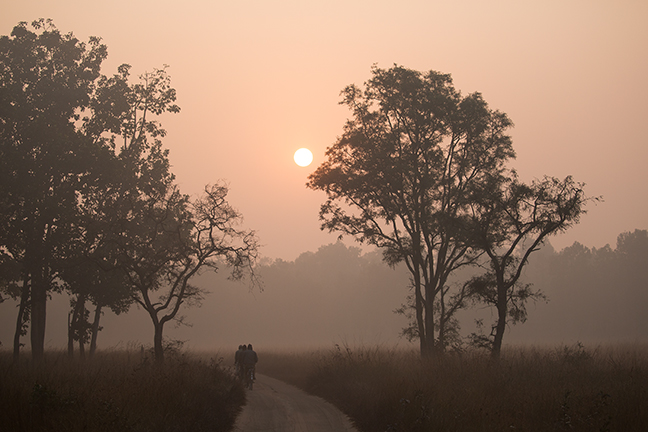
In the Umaria District of Madhya Pradesh in central India lies Bandhavgarh National Park, home of India’s densest population of Bengal Tigers. The park is divided into three zones and those are subdivided into multiple routes. Permits are issued for jeep safaris that pertain to a specific route within a specific zone for either morning or evening access. Hours are limited and limiting with regular tourists being locked out of the park before dawn, during mid-day and after dusk. All vehicles must be driven and guided by Forest Department personnel who are threatened with suspension and fines for crossing into the wrong zone or onto the wrong route, speeding, not exiting the park on time and a variety of other potential offenses.
Vehicles must stay on the roads at all times and foot and bicycle security officers constantly patrol the roads. Tigers use the same roads to traverse the park, so the presence of these government patrols is, at best, a detriment to wildlife viewing. One morning we observed them removing a recently killed fawn from the road, throwing it deep into the brush out of site, as we sat patiently waiting for a predator to return and scavenge the carcass. It is unclear as to their actual purpose, but very clear that they have superiority over drivers and guides, who fear suspension, and that they are not employed to enhance the viewing experience of tourists.
Only about one tenth of the park, the Tala Range, is open to tourism and it is a mix of grasslands and mixed forest. Most tiger sightings are on the dirt roads and this facilitates what resembles the start of the Baja 1000 twice a day, as a dozen or more vehicles race through the gate jostling for position to be the first on their designated route. On some routes, prime tiger habitat is more than 30 minutes away over bumpy dirt roads in open-air jeeps in near freezing morning temperatures. Other wildlife sightings be damned, it is tigers or nothing for these conditioned drivers and guides who realize that tiger sightings generate tips and esteem.
It is a mystery as to how your driver and guide are selected, as they rotate with each drive. Most do not speak English, so unless you speak their local language, you’re not going to ever understand what is going on during your drives. In addition to coming across a random tiger walking on the road, the other way to find tigers is find a convoy of a dozen jeeps fighting for position along and aside the road. Tiger sightings draw a crowd, even though drivers and guides are forbidden from carrying radios. Of course, they have cell phones and word gets around quickly. The Park is closed annually from July 1 – October 15 during the monsoon and breeding seasons.
The Park also offers elephant and VIP safaris that have a higher rate of tiger sightings, especially because they have access to denning and kill sites that are closed to the public when located. Most parks have banned elephant safaris because elephants often displace tigers.
Once you adapt or surrender to the local way of doing things, there are abundant Spotted and Sambar Deer, Rhesus Macaques, Gray Langurs, Wild Boars and numerous beautiful birds easily observed throughout the park and potential sightings of Sloth Bears, Leopards, Jungle Cats, Jackals, reintroduced Gaurs, and other less common residents. If you can find a way to convey your desire to observe and enjoy the variety of wildlife rather than chasing after invisible tigers all day, it is a wonderful park for wildlife viewing and photography. (1/18)
©Rich Beckman
Morning bicycle patrol in Zone 2

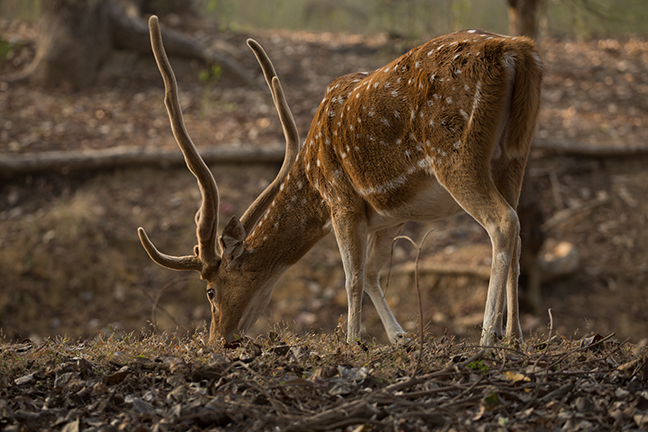
In the Umaria District of Madhya Pradesh in central India lies Bandhavgarh National Park, home of India’s densest population of Bengal Tigers. The park is divided into three zones and those are subdivided into multiple routes. Permits are issued for jeep safaris that pertain to a specific route within a specific zone for either morning or evening access. Hours are limited and limiting with regular tourists being locked out of the park before dawn, during mid-day and after dusk. All vehicles must be driven and guided by Forest Department personnel who are threatened with suspension and fines for crossing into the wrong zone or onto the wrong route, speeding, not exiting the park on time and a variety of other potential offenses.
Vehicles must stay on the roads at all times and foot and bicycle security officers constantly patrol the roads. Tigers use the same roads to traverse the park, so the presence of these government patrols is, at best, a detriment to wildlife viewing. One morning we observed them removing a recently killed fawn from the road, throwing it deep into the brush out of site, as we sat patiently waiting for a predator to return and scavenge the carcass. It is unclear as to their actual purpose, but very clear that they have superiority over drivers and guides, who fear suspension, and that they are not employed to enhance the viewing experience of tourists.
Only about one tenth of the park, the Tala Range, is open to tourism and it is a mix of grasslands and mixed forest. Most tiger sightings are on the dirt roads and this facilitates what resembles the start of the Baja 1000 twice a day, as a dozen or more vehicles race through the gate jostling for position to be the first on their designated route. On some routes, prime tiger habitat is more than 30 minutes away over bumpy dirt roads in open-air jeeps in near freezing morning temperatures. Other wildlife sightings be damned, it is tigers or nothing for these conditioned drivers and guides who realize that tiger sightings generate tips and esteem.
It is a mystery as to how your driver and guide are selected, as they rotate with each drive. Most do not speak English, so unless you speak their local language, you’re not going to ever understand what is going on during your drives. In addition to coming across a random tiger walking on the road, the other way to find tigers is find a convoy of a dozen jeeps fighting for position along and aside the road. Tiger sightings draw a crowd, even though drivers and guides are forbidden from carrying radios. Of course, they have cell phones and word gets around quickly. The Park is closed annually from July 1 – October 15 during the monsoon and breeding seasons.
The Park also offers elephant and VIP safaris that have a higher rate of tiger sightings, especially because they have access to denning and kill sites that are closed to the public when located. Most parks have banned elephant safaris because elephants often displace tigers.
Once you adapt or surrender to the local way of doing things, there are abundant Spotted and Sambar Deer, Rhesus Macaques, Gray Langurs, Wild Boars and numerous beautiful birds easily observed throughout the park and potential sightings of Sloth Bears, Leopards, Jungle Cats, Jackals, reintroduced Gaurs, and other less common residents. If you can find a way to convey your desire to observe and enjoy the variety of wildlife rather than chasing after invisible tigers all day, it is a wonderful park for wildlife viewing and photography. (2/18)
©Rich Beckman
Spotted Deer buck in velvet

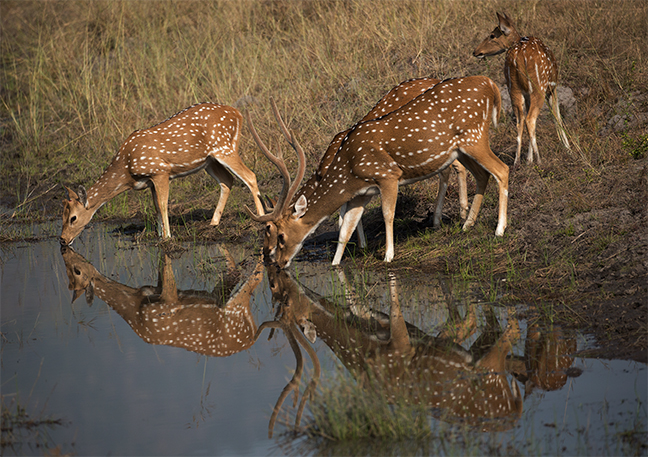
In the Umaria District of Madhya Pradesh in central India lies Bandhavgarh National Park, home of India’s densest population of Bengal Tigers. The park is divided into three zones and those are subdivided into multiple routes. Permits are issued for jeep safaris that pertain to a specific route within a specific zone for either morning or evening access. Hours are limited and limiting with regular tourists being locked out of the park before dawn, during mid-day and after dusk. All vehicles must be driven and guided by Forest Department personnel who are threatened with suspension and fines for crossing into the wrong zone or onto the wrong route, speeding, not exiting the park on time and a variety of other potential offenses.
Vehicles must stay on the roads at all times and foot and bicycle security officers constantly patrol the roads. Tigers use the same roads to traverse the park, so the presence of these government patrols is, at best, a detriment to wildlife viewing. One morning we observed them removing a recently killed fawn from the road, throwing it deep into the brush out of site, as we sat patiently waiting for a predator to return and scavenge the carcass. It is unclear as to their actual purpose, but very clear that they have superiority over drivers and guides, who fear suspension, and that they are not employed to enhance the viewing experience of tourists.
Only about one tenth of the park, the Tala Range, is open to tourism and it is a mix of grasslands and mixed forest. Most tiger sightings are on the dirt roads and this facilitates what resembles the start of the Baja 1000 twice a day, as a dozen or more vehicles race through the gate jostling for position to be the first on their designated route. On some routes, prime tiger habitat is more than 30 minutes away over bumpy dirt roads in open-air jeeps in near freezing morning temperatures. Other wildlife sightings be damned, it is tigers or nothing for these conditioned drivers and guides who realize that tiger sightings generate tips and esteem.
It is a mystery as to how your driver and guide are selected, as they rotate with each drive. Most do not speak English, so unless you speak their local language, you’re not going to ever understand what is going on during your drives. In addition to coming across a random tiger walking on the road, the other way to find tigers is find a convoy of a dozen jeeps fighting for position along and aside the road. Tiger sightings draw a crowd, even though drivers and guides are forbidden from carrying radios. Of course, they have cell phones and word gets around quickly. The Park is closed annually from July 1 – October 15 during the monsoon and breeding seasons.
The Park also offers elephant and VIP safaris that have a higher rate of tiger sightings, especially because they have access to denning and kill sites that are closed to the public when located. Most parks have banned elephant safaris because elephants often displace tigers.
Once you adapt or surrender to the local way of doing things, there are abundant Spotted and Sambar Deer, Rhesus Macaques, Gray Langurs, Wild Boars and numerous beautiful birds easily observed throughout the park and potential sightings of Sloth Bears, Leopards, Jungle Cats, Jackals, reintroduced Gaurs, and other less common residents. If you can find a way to convey your desire to observe and enjoy the variety of wildlife rather than chasing after invisible tigers all day, it is a wonderful park for wildlife viewing and photography. (3/18)
©Rich Beckman
Spotted Deer at water hole in Zone 1

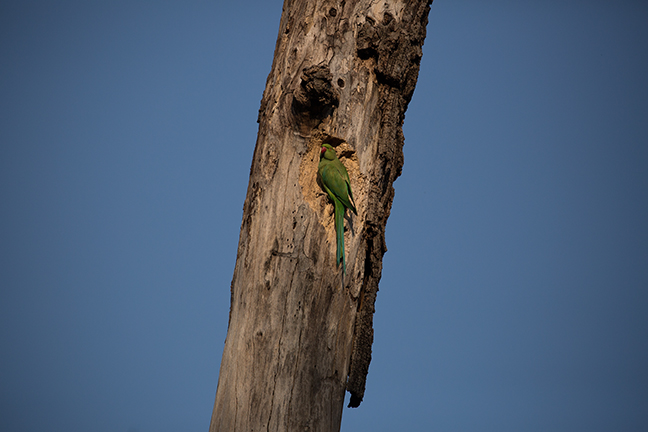
In the Umaria District of Madhya Pradesh in central India lies Bandhavgarh National Park, home of India’s densest population of Bengal Tigers. The park is divided into three zones and those are subdivided into multiple routes. Permits are issued for jeep safaris that pertain to a specific route within a specific zone for either morning or evening access. Hours are limited and limiting with regular tourists being locked out of the park before dawn, during mid-day and after dusk. All vehicles must be driven and guided by Forest Department personnel who are threatened with suspension and fines for crossing into the wrong zone or onto the wrong route, speeding, not exiting the park on time and a variety of other potential offenses.
Vehicles must stay on the roads at all times and foot and bicycle security officers constantly patrol the roads. Tigers use the same roads to traverse the park, so the presence of these government patrols is, at best, a detriment to wildlife viewing. One morning we observed them removing a recently killed fawn from the road, throwing it deep into the brush out of site, as we sat patiently waiting for a predator to return and scavenge the carcass. It is unclear as to their actual purpose, but very clear that they have superiority over drivers and guides, who fear suspension, and that they are not employed to enhance the viewing experience of tourists.
Only about one tenth of the park, the Tala Range, is open to tourism and it is a mix of grasslands and mixed forest. Most tiger sightings are on the dirt roads and this facilitates what resembles the start of the Baja 1000 twice a day, as a dozen or more vehicles race through the gate jostling for position to be the first on their designated route. On some routes, prime tiger habitat is more than 30 minutes away over bumpy dirt roads in open-air jeeps in near freezing morning temperatures. Other wildlife sightings be damned, it is tigers or nothing for these conditioned drivers and guides who realize that tiger sightings generate tips and esteem.
It is a mystery as to how your driver and guide are selected, as they rotate with each drive. Most do not speak English, so unless you speak their local language, you’re not going to ever understand what is going on during your drives. In addition to coming across a random tiger walking on the road, the other way to find tigers is find a convoy of a dozen jeeps fighting for position along and aside the road. Tiger sightings draw a crowd, even though drivers and guides are forbidden from carrying radios. Of course, they have cell phones and word gets around quickly. The Park is closed annually from July 1 – October 15 during the monsoon and breeding seasons.
The Park also offers elephant and VIP safaris that have a higher rate of tiger sightings, especially because they have access to denning and kill sites that are closed to the public when located. Most parks have banned elephant safaris because elephants often displace tigers.
Once you adapt or surrender to the local way of doing things, there are abundant Spotted and Sambar Deer, Rhesus Macaques, Gray Langurs, Wild Boars and numerous beautiful birds easily observed throughout the park and potential sightings of Sloth Bears, Leopards, Jungle Cats, Jackals, reintroduced Gaurs, and other less common residents. If you can find a way to convey your desire to observe and enjoy the variety of wildlife rather than chasing after invisible tigers all day, it is a wonderful park for wildlife viewing and photography. (4/18)
©Rich Beckman
Rose-ringed Parakeet at nest cavity


In the Umaria District of Madhya Pradesh in central India lies Bandhavgarh National Park, home of India’s densest population of Bengal Tigers. The park is divided into three zones and those are subdivided into multiple routes. Permits are issued for jeep safaris that pertain to a specific route within a specific zone for either morning or evening access. Hours are limited and limiting with regular tourists being locked out of the park before dawn, during mid-day and after dusk. All vehicles must be driven and guided by Forest Department personnel who are threatened with suspension and fines for crossing into the wrong zone or onto the wrong route, speeding, not exiting the park on time and a variety of other potential offenses.
Vehicles must stay on the roads at all times and foot and bicycle security officers constantly patrol the roads. Tigers use the same roads to traverse the park, so the presence of these government patrols is, at best, a detriment to wildlife viewing. One morning we observed them removing a recently killed fawn from the road, throwing it deep into the brush out of site, as we sat patiently waiting for a predator to return and scavenge the carcass. It is unclear as to their actual purpose, but very clear that they have superiority over drivers and guides, who fear suspension, and that they are not employed to enhance the viewing experience of tourists.
Only about one tenth of the park, the Tala Range, is open to tourism and it is a mix of grasslands and mixed forest. Most tiger sightings are on the dirt roads and this facilitates what resembles the start of the Baja 1000 twice a day, as a dozen or more vehicles race through the gate jostling for position to be the first on their designated route. On some routes, prime tiger habitat is more than 30 minutes away over bumpy dirt roads in open-air jeeps in near freezing morning temperatures. Other wildlife sightings be damned, it is tigers or nothing for these conditioned drivers and guides who realize that tiger sightings generate tips and esteem.
It is a mystery as to how your driver and guide are selected, as they rotate with each drive. Most do not speak English, so unless you speak their local language, you’re not going to ever understand what is going on during your drives. In addition to coming across a random tiger walking on the road, the other way to find tigers is find a convoy of a dozen jeeps fighting for position along and aside the road. Tiger sightings draw a crowd, even though drivers and guides are forbidden from carrying radios. Of course, they have cell phones and word gets around quickly. The Park is closed annually from July 1 – October 15 during the monsoon and breeding seasons.
The Park also offers elephant and VIP safaris that have a higher rate of tiger sightings, especially because they have access to denning and kill sites that are closed to the public when located. Most parks have banned elephant safaris because elephants often displace tigers.
Once you adapt or surrender to the local way of doing things, there are abundant Spotted and Sambar Deer, Rhesus Macaques, Gray Langurs, Wild Boars and numerous beautiful birds easily observed throughout the park and potential sightings of Sloth Bears, Leopards, Jungle Cats, Jackals, reintroduced Gaurs, and other less common residents. If you can find a way to convey your desire to observe and enjoy the variety of wildlife rather than chasing after invisible tigers all day, it is a wonderful park for wildlife viewing and photography. (5/18)
©Rich Beckman
Reintroduced Gaur (Bos gaurus gaurus)


In the Umaria District of Madhya Pradesh in central India lies Bandhavgarh National Park, home of India’s densest population of Bengal Tigers. The park is divided into three zones and those are subdivided into multiple routes. Permits are issued for jeep safaris that pertain to a specific route within a specific zone for either morning or evening access. Hours are limited and limiting with regular tourists being locked out of the park before dawn, during mid-day and after dusk. All vehicles must be driven and guided by Forest Department personnel who are threatened with suspension and fines for crossing into the wrong zone or onto the wrong route, speeding, not exiting the park on time and a variety of other potential offenses.
Vehicles must stay on the roads at all times and foot and bicycle security officers constantly patrol the roads. Tigers use the same roads to traverse the park, so the presence of these government patrols is, at best, a detriment to wildlife viewing. One morning we observed them removing a recently killed fawn from the road, throwing it deep into the brush out of site, as we sat patiently waiting for a predator to return and scavenge the carcass. It is unclear as to their actual purpose, but very clear that they have superiority over drivers and guides, who fear suspension, and that they are not employed to enhance the viewing experience of tourists.
Only about one tenth of the park, the Tala Range, is open to tourism and it is a mix of grasslands and mixed forest. Most tiger sightings are on the dirt roads and this facilitates what resembles the start of the Baja 1000 twice a day, as a dozen or more vehicles race through the gate jostling for position to be the first on their designated route. On some routes, prime tiger habitat is more than 30 minutes away over bumpy dirt roads in open-air jeeps in near freezing morning temperatures. Other wildlife sightings be damned, it is tigers or nothing for these conditioned drivers and guides who realize that tiger sightings generate tips and esteem.
It is a mystery as to how your driver and guide are selected, as they rotate with each drive. Most do not speak English, so unless you speak their local language, you’re not going to ever understand what is going on during your drives. In addition to coming across a random tiger walking on the road, the other way to find tigers is find a convoy of a dozen jeeps fighting for position along and aside the road. Tiger sightings draw a crowd, even though drivers and guides are forbidden from carrying radios. Of course, they have cell phones and word gets around quickly. The Park is closed annually from July 1 – October 15 during the monsoon and breeding seasons.
The Park also offers elephant and VIP safaris that have a higher rate of tiger sightings, especially because they have access to denning and kill sites that are closed to the public when located. Most parks have banned elephant safaris because elephants often displace tigers.
Once you adapt or surrender to the local way of doing things, there are abundant Spotted and Sambar Deer, Rhesus Macaques, Gray Langurs, Wild Boars and numerous beautiful birds easily observed throughout the park and potential sightings of Sloth Bears, Leopards, Jungle Cats, Jackals, reintroduced Gaurs, and other less common residents. If you can find a way to convey your desire to observe and enjoy the variety of wildlife rather than chasing after invisible tigers all day, it is a wonderful park for wildlife viewing and photography. (6/18)
©Rich Beckman
Rhesus Macaque

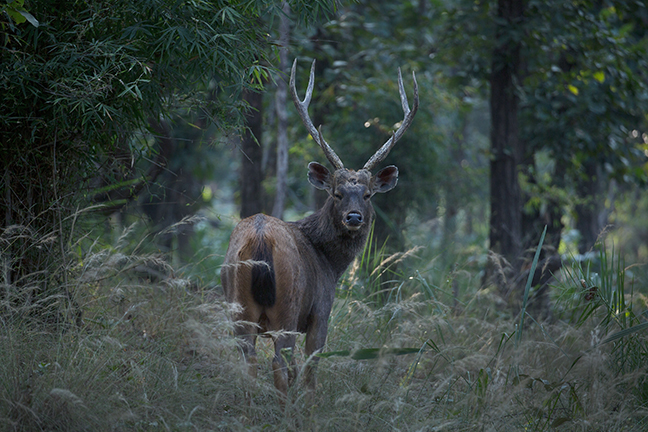
In the Umaria District of Madhya Pradesh in central India lies Bandhavgarh National Park, home of India’s densest population of Bengal Tigers. The park is divided into three zones and those are subdivided into multiple routes. Permits are issued for jeep safaris that pertain to a specific route within a specific zone for either morning or evening access. Hours are limited and limiting with regular tourists being locked out of the park before dawn, during mid-day and after dusk. All vehicles must be driven and guided by Forest Department personnel who are threatened with suspension and fines for crossing into the wrong zone or onto the wrong route, speeding, not exiting the park on time and a variety of other potential offenses.
Vehicles must stay on the roads at all times and foot and bicycle security officers constantly patrol the roads. Tigers use the same roads to traverse the park, so the presence of these government patrols is, at best, a detriment to wildlife viewing. One morning we observed them removing a recently killed fawn from the road, throwing it deep into the brush out of site, as we sat patiently waiting for a predator to return and scavenge the carcass. It is unclear as to their actual purpose, but very clear that they have superiority over drivers and guides, who fear suspension, and that they are not employed to enhance the viewing experience of tourists.
Only about one tenth of the park, the Tala Range, is open to tourism and it is a mix of grasslands and mixed forest. Most tiger sightings are on the dirt roads and this facilitates what resembles the start of the Baja 1000 twice a day, as a dozen or more vehicles race through the gate jostling for position to be the first on their designated route. On some routes, prime tiger habitat is more than 30 minutes away over bumpy dirt roads in open-air jeeps in near freezing morning temperatures. Other wildlife sightings be damned, it is tigers or nothing for these conditioned drivers and guides who realize that tiger sightings generate tips and esteem.
It is a mystery as to how your driver and guide are selected, as they rotate with each drive. Most do not speak English, so unless you speak their local language, you’re not going to ever understand what is going on during your drives. In addition to coming across a random tiger walking on the road, the other way to find tigers is find a convoy of a dozen jeeps fighting for position along and aside the road. Tiger sightings draw a crowd, even though drivers and guides are forbidden from carrying radios. Of course, they have cell phones and word gets around quickly. The Park is closed annually from July 1 – October 15 during the monsoon and breeding seasons.
The Park also offers elephant and VIP safaris that have a higher rate of tiger sightings, especially because they have access to denning and kill sites that are closed to the public when located. Most parks have banned elephant safaris because elephants often displace tigers.
Once you adapt or surrender to the local way of doing things, there are abundant Spotted and Sambar Deer, Rhesus Macaques, Gray Langurs, Wild Boars and numerous beautiful birds easily observed throughout the park and potential sightings of Sloth Bears, Leopards, Jungle Cats, Jackals, reintroduced Gaurs, and other less common residents. If you can find a way to convey your desire to observe and enjoy the variety of wildlife rather than chasing after invisible tigers all day, it is a wonderful park for wildlife viewing and photography. (7/18)
©Rich Beckman
Sambar buck

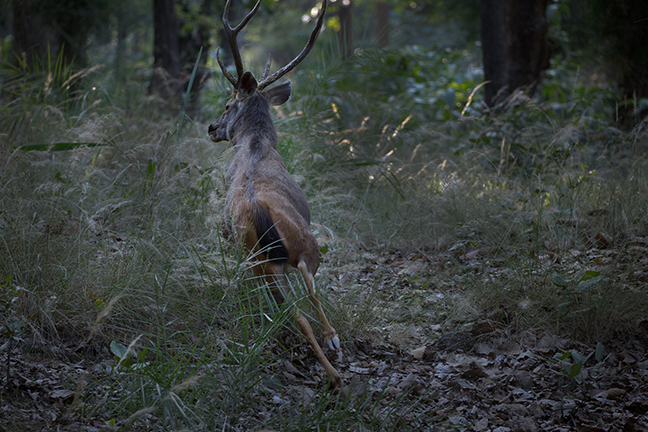
In the Umaria District of Madhya Pradesh in central India lies Bandhavgarh National Park, home of India’s densest population of Bengal Tigers. The park is divided into three zones and those are subdivided into multiple routes. Permits are issued for jeep safaris that pertain to a specific route within a specific zone for either morning or evening access. Hours are limited and limiting with regular tourists being locked out of the park before dawn, during mid-day and after dusk. All vehicles must be driven and guided by Forest Department personnel who are threatened with suspension and fines for crossing into the wrong zone or onto the wrong route, speeding, not exiting the park on time and a variety of other potential offenses.
Vehicles must stay on the roads at all times and foot and bicycle security officers constantly patrol the roads. Tigers use the same roads to traverse the park, so the presence of these government patrols is, at best, a detriment to wildlife viewing. One morning we observed them removing a recently killed fawn from the road, throwing it deep into the brush out of site, as we sat patiently waiting for a predator to return and scavenge the carcass. It is unclear as to their actual purpose, but very clear that they have superiority over drivers and guides, who fear suspension, and that they are not employed to enhance the viewing experience of tourists.
Only about one tenth of the park, the Tala Range, is open to tourism and it is a mix of grasslands and mixed forest. Most tiger sightings are on the dirt roads and this facilitates what resembles the start of the Baja 1000 twice a day, as a dozen or more vehicles race through the gate jostling for position to be the first on their designated route. On some routes, prime tiger habitat is more than 30 minutes away over bumpy dirt roads in open-air jeeps in near freezing morning temperatures. Other wildlife sightings be damned, it is tigers or nothing for these conditioned drivers and guides who realize that tiger sightings generate tips and esteem.
It is a mystery as to how your driver and guide are selected, as they rotate with each drive. Most do not speak English, so unless you speak their local language, you’re not going to ever understand what is going on during your drives. In addition to coming across a random tiger walking on the road, the other way to find tigers is find a convoy of a dozen jeeps fighting for position along and aside the road. Tiger sightings draw a crowd, even though drivers and guides are forbidden from carrying radios. Of course, they have cell phones and word gets around quickly. The Park is closed annually from July 1 – October 15 during the monsoon and breeding seasons.
The Park also offers elephant and VIP safaris that have a higher rate of tiger sightings, especially because they have access to denning and kill sites that are closed to the public when located. Most parks have banned elephant safaris because elephants often displace tigers.
Once you adapt or surrender to the local way of doing things, there are abundant Spotted and Sambar Deer, Rhesus Macaques, Gray Langurs, Wild Boars and numerous beautiful birds easily observed throughout the park and potential sightings of Sloth Bears, Leopards, Jungle Cats, Jackals, reintroduced Gaurs, and other less common residents. If you can find a way to convey your desire to observe and enjoy the variety of wildlife rather than chasing after invisible tigers all day, it is a wonderful park for wildlife viewing and photography. (8/15)
©Rich Beckman
Sambar buck

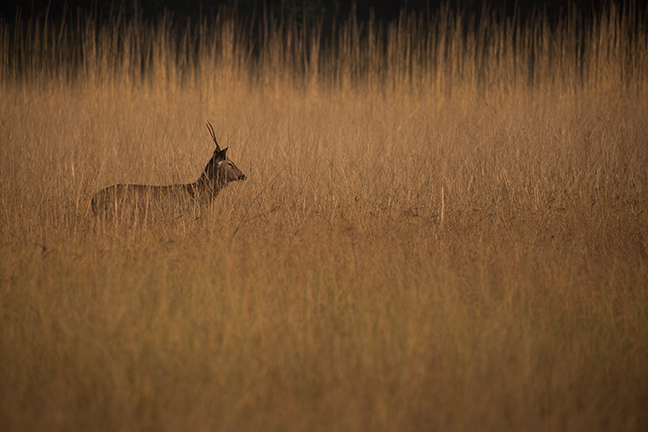
In the Umaria District of Madhya Pradesh in central India lies Bandhavgarh National Park, home of India’s densest population of Bengal Tigers. The park is divided into three zones and those are subdivided into multiple routes. Permits are issued for jeep safaris that pertain to a specific route within a specific zone for either morning or evening access. Hours are limited and limiting with regular tourists being locked out of the park before dawn, during mid-day and after dusk. All vehicles must be driven and guided by Forest Department personnel who are threatened with suspension and fines for crossing into the wrong zone or onto the wrong route, speeding, not exiting the park on time and a variety of other potential offenses.
Vehicles must stay on the roads at all times and foot and bicycle security officers constantly patrol the roads. Tigers use the same roads to traverse the park, so the presence of these government patrols is, at best, a detriment to wildlife viewing. One morning we observed them removing a recently killed fawn from the road, throwing it deep into the brush out of site, as we sat patiently waiting for a predator to return and scavenge the carcass. It is unclear as to their actual purpose, but very clear that they have superiority over drivers and guides, who fear suspension, and that they are not employed to enhance the viewing experience of tourists.
Only about one tenth of the park, the Tala Range, is open to tourism and it is a mix of grasslands and mixed forest. Most tiger sightings are on the dirt roads and this facilitates what resembles the start of the Baja 1000 twice a day, as a dozen or more vehicles race through the gate jostling for position to be the first on their designated route. On some routes, prime tiger habitat is more than 30 minutes away over bumpy dirt roads in open-air jeeps in near freezing morning temperatures. Other wildlife sightings be damned, it is tigers or nothing for these conditioned drivers and guides who realize that tiger sightings generate tips and esteem.
It is a mystery as to how your driver and guide are selected, as they rotate with each drive. Most do not speak English, so unless you speak their local language, you’re not going to ever understand what is going on during your drives. In addition to coming across a random tiger walking on the road, the other way to find tigers is find a convoy of a dozen jeeps fighting for position along and aside the road. Tiger sightings draw a crowd, even though drivers and guides are forbidden from carrying radios. Of course, they have cell phones and word gets around quickly. The Park is closed annually from July 1 – October 15 during the monsoon and breeding seasons.
The Park also offers elephant and VIP safaris that have a higher rate of tiger sightings, especially because they have access to denning and kill sites that are closed to the public when located. Most parks have banned elephant safaris because elephants often displace tigers.
Once you adapt or surrender to the local way of doing things, there are abundant Spotted and Sambar Deer, Rhesus Macaques, Gray Langurs, Wild Boars and numerous beautiful birds easily observed throughout the park and potential sightings of Sloth Bears, Leopards, Jungle Cats, Jackals, reintroduced Gaurs, and other less common residents. If you can find a way to convey your desire to observe and enjoy the variety of wildlife rather than chasing after invisible tigers all day, it is a wonderful park for wildlife viewing and photography. (9/18)
©Rich Beckman
Sambar Buck (subadult)

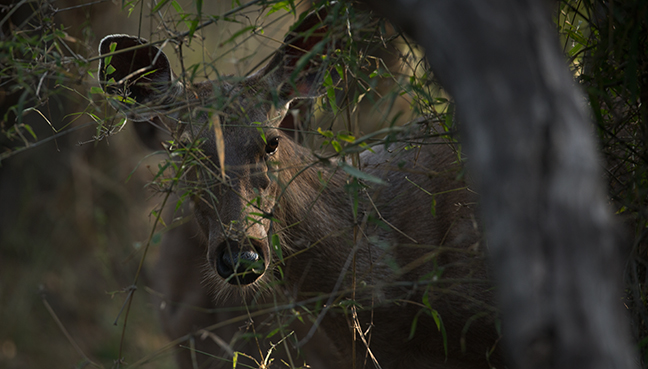
In the Umaria District of Madhya Pradesh in central India lies Bandhavgarh National Park, home of India’s densest population of Bengal Tigers. The park is divided into three zones and those are subdivided into multiple routes. Permits are issued for jeep safaris that pertain to a specific route within a specific zone for either morning or evening access. Hours are limited and limiting with regular tourists being locked out of the park before dawn, during mid-day and after dusk. All vehicles must be driven and guided by Forest Department personnel who are threatened with suspension and fines for crossing into the wrong zone or onto the wrong route, speeding, not exiting the park on time and a variety of other potential offenses.
Vehicles must stay on the roads at all times and foot and bicycle security officers constantly patrol the roads. Tigers use the same roads to traverse the park, so the presence of these government patrols is, at best, a detriment to wildlife viewing. One morning we observed them removing a recently killed fawn from the road, throwing it deep into the brush out of site, as we sat patiently waiting for a predator to return and scavenge the carcass. It is unclear as to their actual purpose, but very clear that they have superiority over drivers and guides, who fear suspension, and that they are not employed to enhance the viewing experience of tourists.
Only about one tenth of the park, the Tala Range, is open to tourism and it is a mix of grasslands and mixed forest. Most tiger sightings are on the dirt roads and this facilitates what resembles the start of the Baja 1000 twice a day, as a dozen or more vehicles race through the gate jostling for position to be the first on their designated route. On some routes, prime tiger habitat is more than 30 minutes away over bumpy dirt roads in open-air jeeps in near freezing morning temperatures. Other wildlife sightings be damned, it is tigers or nothing for these conditioned drivers and guides who realize that tiger sightings generate tips and esteem.
It is a mystery as to how your driver and guide are selected, as they rotate with each drive. Most do not speak English, so unless you speak their local language, you’re not going to ever understand what is going on during your drives. In addition to coming across a random tiger walking on the road, the other way to find tigers is find a convoy of a dozen jeeps fighting for position along and aside the road. Tiger sightings draw a crowd, even though drivers and guides are forbidden from carrying radios. Of course, they have cell phones and word gets around quickly. The Park is closed annually from July 1 – October 15 during the monsoon and breeding seasons.
The Park also offers elephant and VIP safaris that have a higher rate of tiger sightings, especially because they have access to denning and kill sites that are closed to the public when located. Most parks have banned elephant safaris because elephants often displace tigers.
Once you adapt or surrender to the local way of doing things, there are abundant Spotted and Sambar Deer, Rhesus Macaques, Gray Langurs, Wild Boars and numerous beautiful birds easily observed throughout the park and potential sightings of Sloth Bears, Leopards, Jungle Cats, Jackals, reintroduced Gaurs, and other less common residents. If you can find a way to convey your desire to observe and enjoy the variety of wildlife rather than chasing after invisible tigers all day, it is a wonderful park for wildlife viewing and photography. (10/18)
©Rich Beckman
Sambar doe

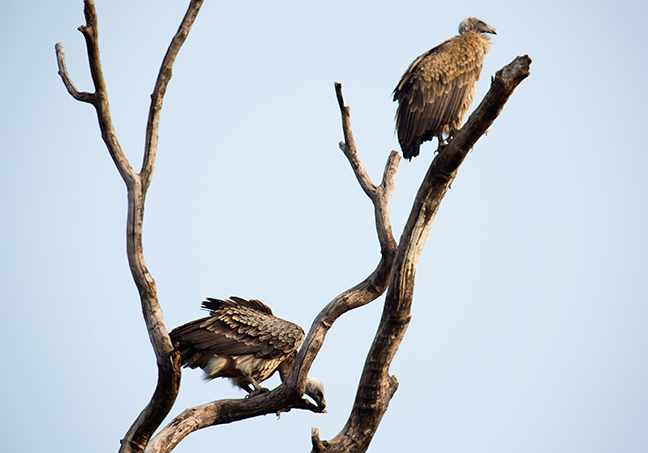
In the Umaria District of Madhya Pradesh in central India lies Bandhavgarh National Park, home of India’s densest population of Bengal Tigers. The park is divided into three zones and those are subdivided into multiple routes. Permits are issued for jeep safaris that pertain to a specific route within a specific zone for either morning or evening access. Hours are limited and limiting with regular tourists being locked out of the park before dawn, during mid-day and after dusk. All vehicles must be driven and guided by Forest Department personnel who are threatened with suspension and fines for crossing into the wrong zone or onto the wrong route, speeding, not exiting the park on time and a variety of other potential offenses.
Vehicles must stay on the roads at all times and foot and bicycle security officers constantly patrol the roads. Tigers use the same roads to traverse the park, so the presence of these government patrols is, at best, a detriment to wildlife viewing. One morning we observed them removing a recently killed fawn from the road, throwing it deep into the brush out of site, as we sat patiently waiting for a predator to return and scavenge the carcass. It is unclear as to their actual purpose, but very clear that they have superiority over drivers and guides, who fear suspension, and that they are not employed to enhance the viewing experience of tourists.
Only about one tenth of the park, the Tala Range, is open to tourism and it is a mix of grasslands and mixed forest. Most tiger sightings are on the dirt roads and this facilitates what resembles the start of the Baja 1000 twice a day, as a dozen or more vehicles race through the gate jostling for position to be the first on their designated route. On some routes, prime tiger habitat is more than 30 minutes away over bumpy dirt roads in open-air jeeps in near freezing morning temperatures. Other wildlife sightings be damned, it is tigers or nothing for these conditioned drivers and guides who realize that tiger sightings generate tips and esteem.
It is a mystery as to how your driver and guide are selected, as they rotate with each drive. Most do not speak English, so unless you speak their local language, you’re not going to ever understand what is going on during your drives. In addition to coming across a random tiger walking on the road, the other way to find tigers is find a convoy of a dozen jeeps fighting for position along and aside the road. Tiger sightings draw a crowd, even though drivers and guides are forbidden from carrying radios. Of course, they have cell phones and word gets around quickly. The Park is closed annually from July 1 – October 15 during the monsoon and breeding seasons.
The Park also offers elephant and VIP safaris that have a higher rate of tiger sightings, especially because they have access to denning and kill sites that are closed to the public when located. Most parks have banned elephant safaris because elephants often displace tigers.
Once you adapt or surrender to the local way of doing things, there are abundant Spotted and Sambar Deer, Rhesus Macaques, Gray Langurs, Wild Boars and numerous beautiful birds easily observed throughout the park and potential sightings of Sloth Bears, Leopards, Jungle Cats, Jackals, reintroduced Gaurs, and other less common residents. If you can find a way to convey your desire to observe and enjoy the variety of wildlife rather than chasing after invisible tigers all day, it is a wonderful park for wildlife viewing and photography. (11/18)
©Rich Beckman
White-rumped Vultures (Gyps bengalensis)

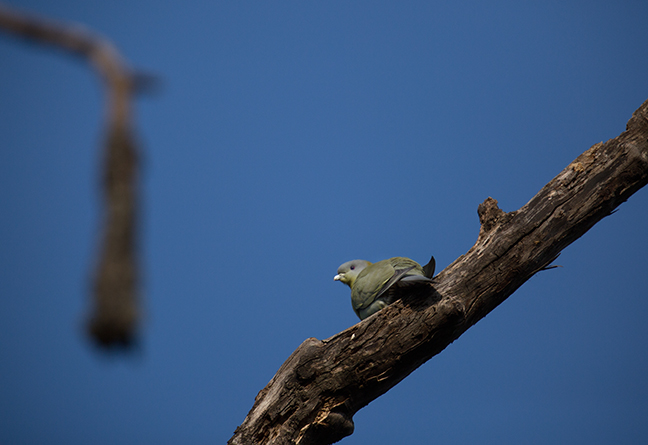
In the Umaria District of Madhya Pradesh in central India lies Bandhavgarh National Park, home of India’s densest population of Bengal Tigers. The park is divided into three zones and those are subdivided into multiple routes. Permits are issued for jeep safaris that pertain to a specific route within a specific zone for either morning or evening access. Hours are limited and limiting with regular tourists being locked out of the park before dawn, during mid-day and after dusk. All vehicles must be driven and guided by Forest Department personnel who are threatened with suspension and fines for crossing into the wrong zone or onto the wrong route, speeding, not exiting the park on time and a variety of other potential offenses.
Vehicles must stay on the roads at all times and foot and bicycle security officers constantly patrol the roads. Tigers use the same roads to traverse the park, so the presence of these government patrols is, at best, a detriment to wildlife viewing. One morning we observed them removing a recently killed fawn from the road, throwing it deep into the brush out of site, as we sat patiently waiting for a predator to return and scavenge the carcass. It is unclear as to their actual purpose, but very clear that they have superiority over drivers and guides, who fear suspension, and that they are not employed to enhance the viewing experience of tourists.
Only about one tenth of the park, the Tala Range, is open to tourism and it is a mix of grasslands and mixed forest. Most tiger sightings are on the dirt roads and this facilitates what resembles the start of the Baja 1000 twice a day, as a dozen or more vehicles race through the gate jostling for position to be the first on their designated route. On some routes, prime tiger habitat is more than 30 minutes away over bumpy dirt roads in open-air jeeps in near freezing morning temperatures. Other wildlife sightings be damned, it is tigers or nothing for these conditioned drivers and guides who realize that tiger sightings generate tips and esteem.
It is a mystery as to how your driver and guide are selected, as they rotate with each drive. Most do not speak English, so unless you speak their local language, you’re not going to ever understand what is going on during your drives. In addition to coming across a random tiger walking on the road, the other way to find tigers is find a convoy of a dozen jeeps fighting for position along and aside the road. Tiger sightings draw a crowd, even though drivers and guides are forbidden from carrying radios. Of course, they have cell phones and word gets around quickly. The Park is closed annually from July 1 – October 15 during the monsoon and breeding seasons.
The Park also offers elephant and VIP safaris that have a higher rate of tiger sightings, especially because they have access to denning and kill sites that are closed to the public when located. Most parks have banned elephant safaris because elephants often displace tigers.
Once you adapt or surrender to the local way of doing things, there are abundant Spotted and Sambar Deer, Rhesus Macaques, Gray Langurs, Wild Boars and numerous beautiful birds easily observed throughout the park and potential sightings of Sloth Bears, Leopards, Jungle Cats, Jackals, reintroduced Gaurs, and other less common residents. If you can find a way to convey your desire to observe and enjoy the variety of wildlife rather than chasing after invisible tigers all day, it is a wonderful park for wildlife viewing and photography. (12/18)
©Rich Beckman
Yellow-footed Green Pigeon

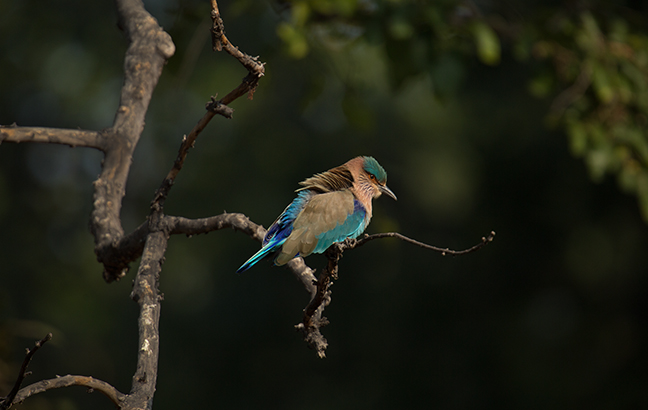
In the Umaria District of Madhya Pradesh in central India lies Bandhavgarh National Park, home of India’s densest population of Bengal Tigers. The park is divided into three zones and those are subdivided into multiple routes. Permits are issued for jeep safaris that pertain to a specific route within a specific zone for either morning or evening access. Hours are limited and limiting with regular tourists being locked out of the park before dawn, during mid-day and after dusk. All vehicles must be driven and guided by Forest Department personnel who are threatened with suspension and fines for crossing into the wrong zone or onto the wrong route, speeding, not exiting the park on time and a variety of other potential offenses.
Vehicles must stay on the roads at all times and foot and bicycle security officers constantly patrol the roads. Tigers use the same roads to traverse the park, so the presence of these government patrols is, at best, a detriment to wildlife viewing. One morning we observed them removing a recently killed fawn from the road, throwing it deep into the brush out of site, as we sat patiently waiting for a predator to return and scavenge the carcass. It is unclear as to their actual purpose, but very clear that they have superiority over drivers and guides, who fear suspension, and that they are not employed to enhance the viewing experience of tourists.
Only about one tenth of the park, the Tala Range, is open to tourism and it is a mix of grasslands and mixed forest. Most tiger sightings are on the dirt roads and this facilitates what resembles the start of the Baja 1000 twice a day, as a dozen or more vehicles race through the gate jostling for position to be the first on their designated route. On some routes, prime tiger habitat is more than 30 minutes away over bumpy dirt roads in open-air jeeps in near freezing morning temperatures. Other wildlife sightings be damned, it is tigers or nothing for these conditioned drivers and guides who realize that tiger sightings generate tips and esteem.
It is a mystery as to how your driver and guide are selected, as they rotate with each drive. Most do not speak English, so unless you speak their local language, you’re not going to ever understand what is going on during your drives. In addition to coming across a random tiger walking on the road, the other way to find tigers is find a convoy of a dozen jeeps fighting for position along and aside the road. Tiger sightings draw a crowd, even though drivers and guides are forbidden from carrying radios. Of course, they have cell phones and word gets around quickly. The Park is closed annually from July 1 – October 15 during the monsoon and breeding seasons.
The Park also offers elephant and VIP safaris that have a higher rate of tiger sightings, especially because they have access to denning and kill sites that are closed to the public when located. Most parks have banned elephant safaris because elephants often displace tigers.
Once you adapt or surrender to the local way of doing things, there are abundant Spotted and Sambar Deer, Rhesus Macaques, Gray Langurs, Wild Boars and numerous beautiful birds easily observed throughout the park and potential sightings of Sloth Bears, Leopards, Jungle Cats, Jackals, reintroduced Gaurs, and other less common residents. If you can find a way to convey your desire to observe and enjoy the variety of wildlife rather than chasing after invisible tigers all day, it is a wonderful park for wildlife viewing and photography. (13/18)
©Rich Beckman
Indian Roller (Coracias benghalensis)

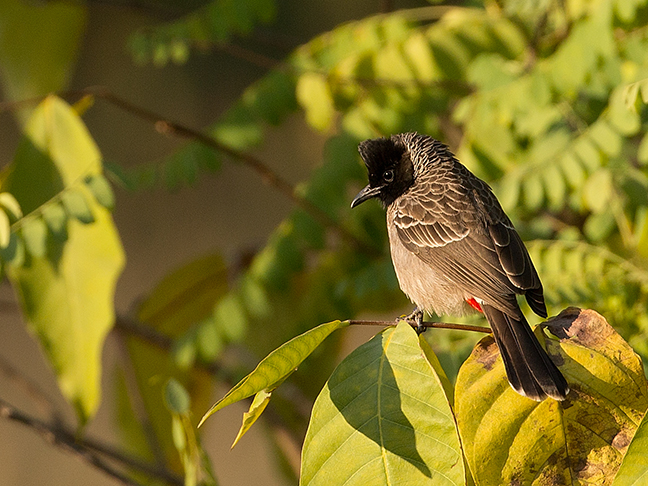
In the Umaria District of Madhya Pradesh in central India lies Bandhavgarh National Park, home of India’s densest population of Bengal Tigers. The park is divided into three zones and those are subdivided into multiple routes. Permits are issued for jeep safaris that pertain to a specific route within a specific zone for either morning or evening access. Hours are limited and limiting with regular tourists being locked out of the park before dawn, during mid-day and after dusk. All vehicles must be driven and guided by Forest Department personnel who are threatened with suspension and fines for crossing into the wrong zone or onto the wrong route, speeding, not exiting the park on time and a variety of other potential offenses.
Vehicles must stay on the roads at all times and foot and bicycle security officers constantly patrol the roads. Tigers use the same roads to traverse the park, so the presence of these government patrols is, at best, a detriment to wildlife viewing. One morning we observed them removing a recently killed fawn from the road, throwing it deep into the brush out of site, as we sat patiently waiting for a predator to return and scavenge the carcass. It is unclear as to their actual purpose, but very clear that they have superiority over drivers and guides, who fear suspension, and that they are not employed to enhance the viewing experience of tourists.
Only about one tenth of the park, the Tala Range, is open to tourism and it is a mix of grasslands and mixed forest. Most tiger sightings are on the dirt roads and this facilitates what resembles the start of the Baja 1000 twice a day, as a dozen or more vehicles race through the gate jostling for position to be the first on their designated route. On some routes, prime tiger habitat is more than 30 minutes away over bumpy dirt roads in open-air jeeps in near freezing morning temperatures. Other wildlife sightings be damned, it is tigers or nothing for these conditioned drivers and guides who realize that tiger sightings generate tips and esteem.
It is a mystery as to how your driver and guide are selected, as they rotate with each drive. Most do not speak English, so unless you speak their local language, you’re not going to ever understand what is going on during your drives. In addition to coming across a random tiger walking on the road, the other way to find tigers is find a convoy of a dozen jeeps fighting for position along and aside the road. Tiger sightings draw a crowd, even though drivers and guides are forbidden from carrying radios. Of course, they have cell phones and word gets around quickly. The Park is closed annually from July 1 – October 15 during the monsoon and breeding seasons.
The Park also offers elephant and VIP safaris that have a higher rate of tiger sightings, especially because they have access to denning and kill sites that are closed to the public when located. Most parks have banned elephant safaris because elephants often displace tigers.
Once you adapt or surrender to the local way of doing things, there are abundant Spotted and Sambar Deer, Rhesus Macaques, Gray Langurs, Wild Boars and numerous beautiful birds easily observed throughout the park and potential sightings of Sloth Bears, Leopards, Jungle Cats, Jackals, reintroduced Gaurs, and other less common residents. If you can find a way to convey your desire to observe and enjoy the variety of wildlife rather than chasing after invisible tigers all day, it is a wonderful park for wildlife viewing and photography. (14/18)
©Rich Beckman
Red-vented Bulbul (Pycnonotus cafer)

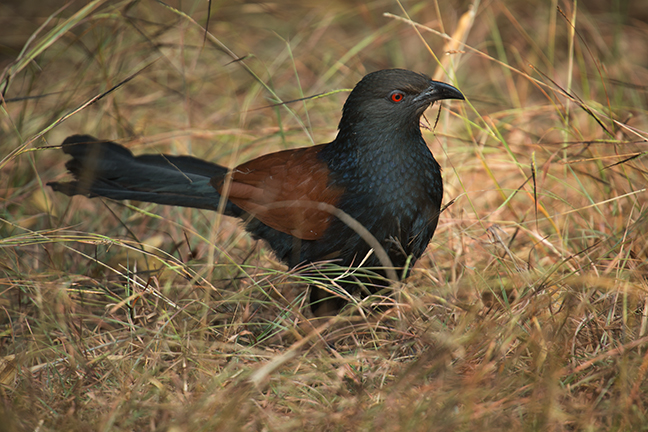
In the Umaria District of Madhya Pradesh in central India lies Bandhavgarh National Park, home of India’s densest population of Bengal Tigers. The park is divided into three zones and those are subdivided into multiple routes. Permits are issued for jeep safaris that pertain to a specific route within a specific zone for either morning or evening access. Hours are limited and limiting with regular tourists being locked out of the park before dawn, during mid-day and after dusk. All vehicles must be driven and guided by Forest Department personnel who are threatened with suspension and fines for crossing into the wrong zone or onto the wrong route, speeding, not exiting the park on time and a variety of other potential offenses.
Vehicles must stay on the roads at all times and foot and bicycle security officers constantly patrol the roads. Tigers use the same roads to traverse the park, so the presence of these government patrols is, at best, a detriment to wildlife viewing. One morning we observed them removing a recently killed fawn from the road, throwing it deep into the brush out of site, as we sat patiently waiting for a predator to return and scavenge the carcass. It is unclear as to their actual purpose, but very clear that they have superiority over drivers and guides, who fear suspension, and that they are not employed to enhance the viewing experience of tourists.
Only about one tenth of the park, the Tala Range, is open to tourism and it is a mix of grasslands and mixed forest. Most tiger sightings are on the dirt roads and this facilitates what resembles the start of the Baja 1000 twice a day, as a dozen or more vehicles race through the gate jostling for position to be the first on their designated route. On some routes, prime tiger habitat is more than 30 minutes away over bumpy dirt roads in open-air jeeps in near freezing morning temperatures. Other wildlife sightings be damned, it is tigers or nothing for these conditioned drivers and guides who realize that tiger sightings generate tips and esteem.
It is a mystery as to how your driver and guide are selected, as they rotate with each drive. Most do not speak English, so unless you speak their local language, you’re not going to ever understand what is going on during your drives. In addition to coming across a random tiger walking on the road, the other way to find tigers is find a convoy of a dozen jeeps fighting for position along and aside the road. Tiger sightings draw a crowd, even though drivers and guides are forbidden from carrying radios. Of course, they have cell phones and word gets around quickly. The Park is closed annually from July 1 – October 15 during the monsoon and breeding seasons.
The Park also offers elephant and VIP safaris that have a higher rate of tiger sightings, especially because they have access to denning and kill sites that are closed to the public when located. Most parks have banned elephant safaris because elephants often displace tigers.
Once you adapt or surrender to the local way of doing things, there are abundant Spotted and Sambar Deer, Rhesus Macaques, Gray Langurs, Wild Boars and numerous beautiful birds easily observed throughout the park and potential sightings of Sloth Bears, Leopards, Jungle Cats, Jackals, reintroduced Gaurs, and other less common residents. If you can find a way to convey your desire to observe and enjoy the variety of wildlife rather than chasing after invisible tigers all day, it is a wonderful park for wildlife viewing and photography. (15/18)
©Rich Beckman
Greater Coucal or Crow Pheasant (Centropus sinensis)

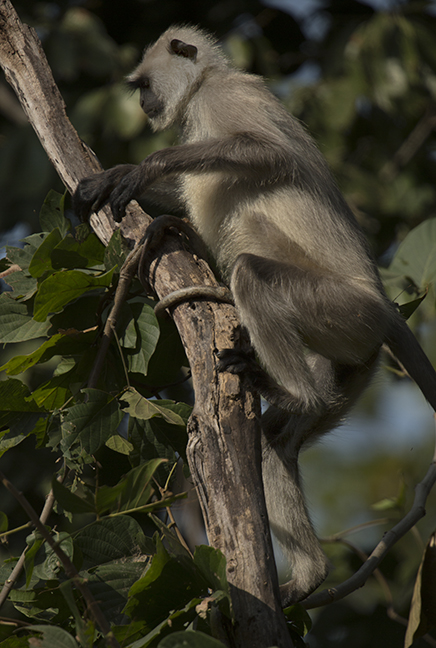
In the Umaria District of Madhya Pradesh in central India lies Bandhavgarh National Park, home of India’s densest population of Bengal Tigers. The park is divided into three zones and those are subdivided into multiple routes. Permits are issued for jeep safaris that pertain to a specific route within a specific zone for either morning or evening access. Hours are limited and limiting with regular tourists being locked out of the park before dawn, during mid-day and after dusk. All vehicles must be driven and guided by Forest Department personnel who are threatened with suspension and fines for crossing into the wrong zone or onto the wrong route, speeding, not exiting the park on time and a variety of other potential offenses.
Vehicles must stay on the roads at all times and foot and bicycle security officers constantly patrol the roads. Tigers use the same roads to traverse the park, so the presence of these government patrols is, at best, a detriment to wildlife viewing. One morning we observed them removing a recently killed fawn from the road, throwing it deep into the brush out of site, as we sat patiently waiting for a predator to return and scavenge the carcass. It is unclear as to their actual purpose, but very clear that they have superiority over drivers and guides, who fear suspension, and that they are not employed to enhance the viewing experience of tourists.
Only about one tenth of the park, the Tala Range, is open to tourism and it is a mix of grasslands and mixed forest. Most tiger sightings are on the dirt roads and this facilitates what resembles the start of the Baja 1000 twice a day, as a dozen or more vehicles race through the gate jostling for position to be the first on their designated route. On some routes, prime tiger habitat is more than 30 minutes away over bumpy dirt roads in open-air jeeps in near freezing morning temperatures. Other wildlife sightings be damned, it is tigers or nothing for these conditioned drivers and guides who realize that tiger sightings generate tips and esteem.
It is a mystery as to how your driver and guide are selected, as they rotate with each drive. Most do not speak English, so unless you speak their local language, you’re not going to ever understand what is going on during your drives. In addition to coming across a random tiger walking on the road, the other way to find tigers is find a convoy of a dozen jeeps fighting for position along and aside the road. Tiger sightings draw a crowd, even though drivers and guides are forbidden from carrying radios. Of course, they have cell phones and word gets around quickly. The Park is closed annually from July 1 – October 15 during the monsoon and breeding seasons.
The Park also offers elephant and VIP safaris that have a higher rate of tiger sightings, especially because they have access to denning and kill sites that are closed to the public when located. Most parks have banned elephant safaris because elephants often displace tigers.
Once you adapt or surrender to the local way of doing things, there are abundant Spotted and Sambar Deer, Rhesus Macaques, Gray Langurs, Wild Boars and numerous beautiful birds easily observed throughout the park and potential sightings of Sloth Bears, Leopards, Jungle Cats, Jackals, reintroduced Gaurs, and other less common residents. If you can find a way to convey your desire to observe and enjoy the variety of wildlife rather than chasing after invisible tigers all day, it is a wonderful park for wildlife viewing and photography. (16/18)
©Rich Beckman
Gray or Hanuman Langurs (Semnopithecus entellus)

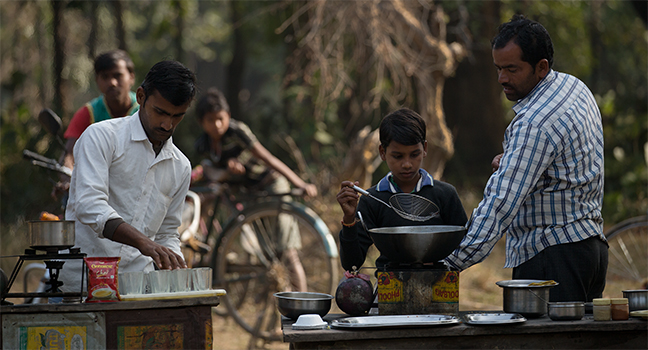
In the Umaria District of Madhya Pradesh in central India lies Bandhavgarh National Park, home of India’s densest population of Bengal Tigers. The park is divided into three zones and those are subdivided into multiple routes. Permits are issued for jeep safaris that pertain to a specific route within a specific zone for either morning or evening access. Hours are limited and limiting with regular tourists being locked out of the park before dawn, during mid-day and after dusk. All vehicles must be driven and guided by Forest Department personnel who are threatened with suspension and fines for crossing into the wrong zone or onto the wrong route, speeding, not exiting the park on time and a variety of other potential offenses.
Vehicles must stay on the roads at all times and foot and bicycle security officers constantly patrol the roads. Tigers use the same roads to traverse the park, so the presence of these government patrols is, at best, a detriment to wildlife viewing. One morning we observed them removing a recently killed fawn from the road, throwing it deep into the brush out of site, as we sat patiently waiting for a predator to return and scavenge the carcass. It is unclear as to their actual purpose, but very clear that they have superiority over drivers and guides, who fear suspension, and that they are not employed to enhance the viewing experience of tourists.
Only about one tenth of the park, the Tala Range, is open to tourism and it is a mix of grasslands and mixed forest. Most tiger sightings are on the dirt roads and this facilitates what resembles the start of the Baja 1000 twice a day, as a dozen or more vehicles race through the gate jostling for position to be the first on their designated route. On some routes, prime tiger habitat is more than 30 minutes away over bumpy dirt roads in open-air jeeps in near freezing morning temperatures. Other wildlife sightings be damned, it is tigers or nothing for these conditioned drivers and guides who realize that tiger sightings generate tips and esteem.
It is a mystery as to how your driver and guide are selected, as they rotate with each drive. Most do not speak English, so unless you speak their local language, you’re not going to ever understand what is going on during your drives. In addition to coming across a random tiger walking on the road, the other way to find tigers is find a convoy of a dozen jeeps fighting for position along and aside the road. Tiger sightings draw a crowd, even though drivers and guides are forbidden from carrying radios. Of course, they have cell phones and word gets around quickly. The Park is closed annually from July 1 – October 15 during the monsoon and breeding seasons.
The Park also offers elephant and VIP safaris that have a higher rate of tiger sightings, especially because they have access to denning and kill sites that are closed to the public when located. Most parks have banned elephant safaris because elephants often displace tigers.
Once you adapt or surrender to the local way of doing things, there are abundant Spotted and Sambar Deer, Rhesus Macaques, Gray Langurs, Wild Boars and numerous beautiful birds easily observed throughout the park and potential sightings of Sloth Bears, Leopards, Jungle Cats, Jackals, reintroduced Gaurs, and other less common residents. If you can find a way to convey your desire to observe and enjoy the variety of wildlife rather than chasing after invisible tigers all day, it is a wonderful park for wildlife viewing and photography. (17/18)
©Rich Beckman
Snack Bar, Bandhavgarh National Park

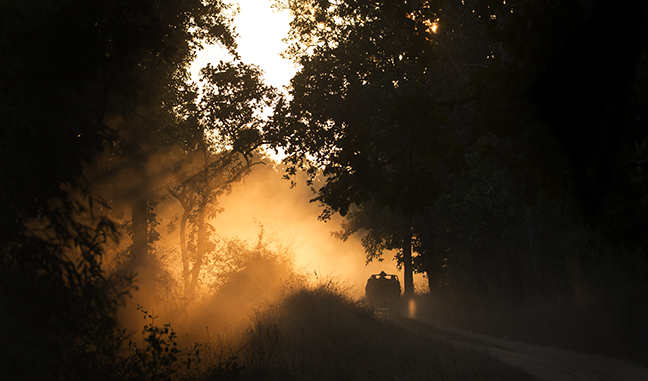
In the Umaria District of Madhya Pradesh in central India lies Bandhavgarh National Park, home of India’s densest population of Bengal Tigers. The park is divided into three zones and those are subdivided into multiple routes. Permits are issued for jeep safaris that pertain to a specific route within a specific zone for either morning or evening access. Hours are limited and limiting with regular tourists being locked out of the park before dawn, during mid-day and after dusk. All vehicles must be driven and guided by Forest Department personnel who are threatened with suspension and fines for crossing into the wrong zone or onto the wrong route, speeding, not exiting the park on time and a variety of other potential offenses.
Vehicles must stay on the roads at all times and foot and bicycle security officers constantly patrol the roads. Tigers use the same roads to traverse the park, so the presence of these government patrols is, at best, a detriment to wildlife viewing. One morning we observed them removing a recently killed fawn from the road, throwing it deep into the brush out of site, as we sat patiently waiting for a predator to return and scavenge the carcass. It is unclear as to their actual purpose, but very clear that they have superiority over drivers and guides, who fear suspension, and that they are not employed to enhance the viewing experience of tourists.
Only about one tenth of the park, the Tala Range, is open to tourism and it is a mix of grasslands and mixed forest. Most tiger sightings are on the dirt roads and this facilitates what resembles the start of the Baja 1000 twice a day, as a dozen or more vehicles race through the gate jostling for position to be the first on their designated route. On some routes, prime tiger habitat is more than 30 minutes away over bumpy dirt roads in open-air jeeps in near freezing morning temperatures. Other wildlife sightings be damned, it is tigers or nothing for these conditioned drivers and guides who realize that tiger sightings generate tips and esteem.
It is a mystery as to how your driver and guide are selected, as they rotate with each drive. Most do not speak English, so unless you speak their local language, you’re not going to ever understand what is going on during your drives. In addition to coming across a random tiger walking on the road, the other way to find tigers is find a convoy of a dozen jeeps fighting for position along and aside the road. Tiger sightings draw a crowd, even though drivers and guides are forbidden from carrying radios. Of course, they have cell phones and word gets around quickly. The Park is closed annually from July 1 – October 15 during the monsoon and breeding seasons.
The Park also offers elephant and VIP safaris that have a higher rate of tiger sightings, especially because they have access to denning and kill sites that are closed to the public when located. Most parks have banned elephant safaris because elephants often displace tigers.
Once you adapt or surrender to the local way of doing things, there are abundant Spotted and Sambar Deer, Rhesus Macaques, Gray Langurs, Wild Boars and numerous beautiful birds easily observed throughout the park and potential sightings of Sloth Bears, Leopards, Jungle Cats, Jackals, reintroduced Gaurs, and other less common residents. If you can find a way to convey your desire to observe and enjoy the variety of wildlife rather than chasing after invisible tigers all day, it is a wonderful park for wildlife viewing and photography. (18/18)
©Rich Beckman
Riding through the dust at sunset